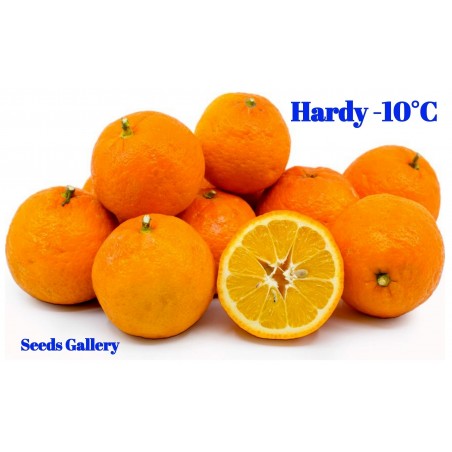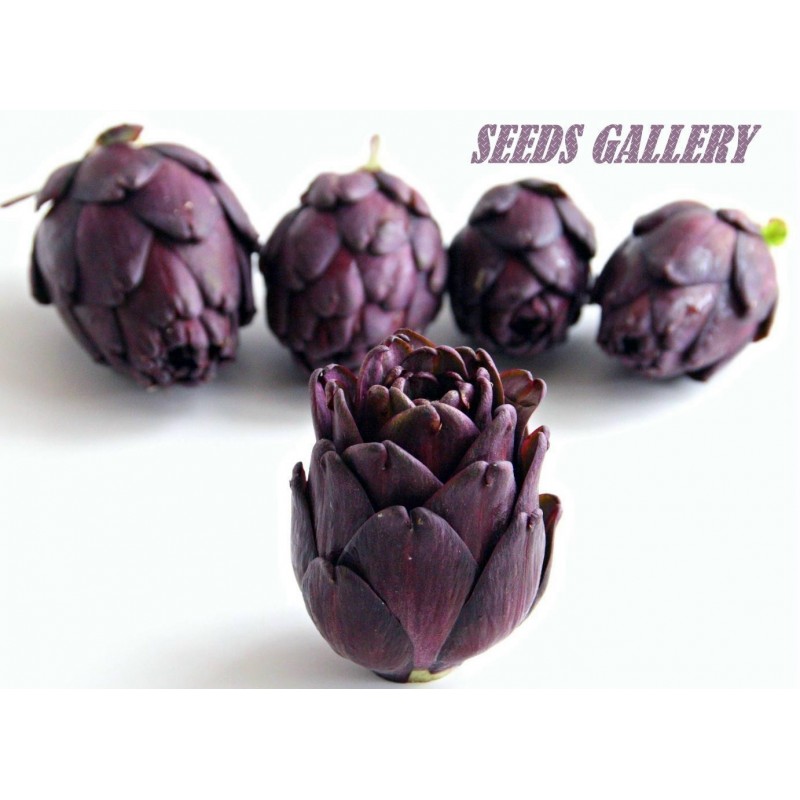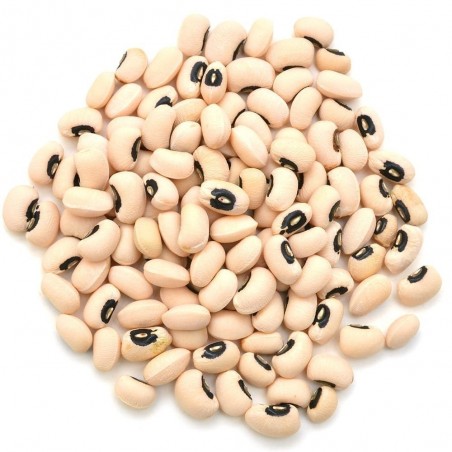
VIOLET DE PROVENCE خرشوف بذور
VIOLET DE PROVENCE خرشوف بذور
ثمن عبوة من +-20 (1g) بذرة.
يعتبر الخرشوف "Violet de Provence" أحد أكثر الخضروات الإيطالية تقليدية. وهي معروفة بمجموعة متنوعة من الأسماء بما في ذلك فيوليتا دي بروفينزا وبويفريد. هذا الخرشوف متوسط الحجم اللذيذ يطور كرات أرضية غنية بنفسجية بنفسجية على نباتات تشبه الشوك.
تزرع من مارس إلى أغسطس والحصاد بين مايو ويوليو. تظل النباتات منتجة لمدة ثلاث سنوات على الأقل.
VIOLET DE PROVENCE خرشوف بذور
ثمن عبوة من +-20 (1g) بذرة.
يعتبر الخرشوف "Violet de Provence" أحد أكثر الخضروات الإيطالية تقليدية. وهي معروفة بمجموعة متنوعة من الأسماء بما في ذلك فيوليتا دي بروفينزا وبويفريد. هذا الخرشوف متوسط الحجم اللذيذ يطور كرات أرضية غنية بنفسجية بنفسجية على نباتات تشبه الشوك.
تزرع من مارس إلى أغسطس والحصاد بين مايو ويوليو. تظل النباتات منتجة لمدة ثلاث سنوات على الأقل.
قليل من الأطباق مرضية لتناول الطعام مثل الخرشوف. اغمس الأوراق في صلصة البلسمك-لحم الخنزير المقدد الدافئة وستقع في حب القليل من الشوك!
Sowing:
Sow under glass February to March or sow outdoors once the soil has warmed for cropping the following year. Sow the seeds at a depth of 6mm (¼in), they should germinate in 10 to14 days.
Transplant in June to crop in autumn and the following May. They need a position that receives eight hours or more sun per day.
Seed sown outdoors flowers the year after sowing. Sow direct when the soil has warmed up in mid spring for cropping the following year. Sow in free draining soil, 2 to 3 seeds in stations 30cm (12in) apart. Thin out so that there is one good plant every 60cm (24in). The thinnings can be transplanted.
Artichokes need constant moisture: water well. They thrive in moderate climates near the sea where the soil has a high salt content. Seaweed is said to be the best fertiliser possible for these plants.
Cultivation:
Keep the plants well watered until established. Apply a mulch around the stems in May. During the summer months hoe regularly and apply a liquid fertiliser at fortnightly intervals. Water thoroughly when the weather is dry. In late autumn cut down the stems and cover the crowns with bracken, leaves or straw. Remove this protective covering in April.
Harvesting:
Artichokes come in different sizes: baby, medium, and jumbo. All three sizes grow on the same plant. The jumbo grows on the centre stalk, the medium grow on the sides, and the babies at the base. They are not merely immature globes. The globes are harvested before the blossoms open to ensure the best flavour.
The size of a mature artichoke is dependent upon its placement on the plant. Those at the top can be enormous while those at the base, shaded by dense leaves, may grow no larger than a ping-pong ball.
As soon as the petals begin to open, they are overripe, no matter the size. After harvesting the main head, secondary heads will appear and these too can be used.
Expected yield per mature plant: 10 to 12 heads. Productive life: 4 years
Storing:
Artichokes can be stored briefly in plastic bags to preserve their moisture content.
Rotation considerations:
Avoid following Jerusalem artichoke or sunflower.
Companion Planting:
Good companions: Sunflower and Tarragon.
Bad companions: None
Other Uses:
Artichokes provide wonderful shades of green when used as a natural dye.
Used in the garden they add structure and height to flower beds. In late summer they have beautiful violet-blue flowers.
Origin:
The origin of artichokes is unknown, though they are said to have come from the Maghreb (North Africa), where they are still found in the wild state; the seeds of artichokes, probably cultivated, were found during the excavation of Mons Claudianus in Egypt during the Roman period. Globe artichokes are known to have been cultivated at Naples around the middle of the 9th century.
The Dutch introduced artichokes to England, where they grew in Henry VIII's garden at Newhall in 1530.
Nomenclature:
The various names of the artichoke in European languages all ultimately come from Arabic al-kharshuf, through a Northern Italian dialect word, articiocco.
The Arabic term Ardi-Shoki which means "ground thorny" is a folk etymology of the English name.
The word Artichoke may also refer to:
The Cardoon, a related species.
Jerusalem artichoke, a species of sunflower
Chinese artichoke, a species of woundwort
Project Artichoke, a CIA operation
| HEIRLOOM ? | Yes |
|---|---|
| بذور العضوية؟ | Organic Seeds |
| العضوية / الطبيعية؟ | Organic/Natural: Yes |
| صالح للأكل؟ | Edible |
| المعالجة من بذر؟ | Soak in water before sowing 12-24 h |
| بذر عمق؟ | Sowing depth 5 mm |
| نبات معمر؟ | Perennial plant : Yes |
| بذور منتقاة بعناية؟ | Handpicked seeds |
| مقاومة للبرودة والصقيع؟ | Resistant to cold and frost |
| النبات مناسب للنمو؟ | The plant is suitable for growing in a greenhouse The plant is suitable for outdoors cultivation |
| ارتفاع النبات ؟ | Plant height (about) 150 - 200 cm |
| وزن الفاكهة؟ | Fruit Weight: 80 - 120 g |
| بلد المنشأ من مجموعة متنوعة؟ | Variety from: Italy |
| نبات طبي ؟ | Medicinal Plant: Yes |
| الاسم العلمي: | Cynara cardunculus var. scolymus |
| Sun Exposure ? | Full sun from an early age |
| Growth Rate ? | Fast Growth Rate |
| Type: | Vegetable Seeds |
| اسم شائع: | Artichoke |
| Planting Time? | Planting Time: Whole year-round |
| Indoor/Outdoor? | Indoor/Outdoor: Outdoor |
| Soil Type? | Soil Type: Appropriate soil |
| Watering? | Watering: Medium |
| Cultivating Difficulty? | Cultivating Difficulty: Very easy |
| Climate? | It thrives in all climatic conditions |


Your review appreciation cannot be sent
Report comment
Report sent
Your report cannot be sent
اكتب تعليقك
Review sent
Your review cannot be sent
🌍 الشحن العالمي من الاتحاد الأوروبي
نقوم بالشحن إلى جميع أنحاء العالم من الاتحاد الأوروبي باستخدام بريد مسجل مع تأكيد استلام.
📦 تتبع الشحنة
لتتبع شحنتك، قم بتسجيل الدخول إلى حسابك، ثم اذهب إلى سجل الطلبات > التفاصيل وستجد رقم التتبع هناك.
التتبع العالمي: 17Track
لتتبع أرقام مثل RGxxxxxxHR: تتبع Posta.hr
🕒 يرجى الانتظار 24 ساعة على الأقل بعد الشحن لظهور معلومات التتبع.
⚠️ ملاحظات هامة
الدفع عند الاستلام غير متاح.
تحقق من مجلد البريد العشوائي/الغير هام في بريدك الإلكتروني للحصول على إشعارات الطلبات.
استخدم فقط نموذج الاتصال الموجود على موقعنا.
لن يتم الرد على الرسائل المرسلة مباشرة إلى بريدنا الإلكتروني.
📱 رقم الهاتف مطلوب
يرجى إدخال رقم هاتفك المحمول مع رمز البلد.
مثال: +966 512 345 678
🚚 شروط التوصيل
تتطلب الشحنات المسجلة توقيع المستلم.
لا تطلب إذا:
كنت تريد التسليم إلى صندوق بريد
لن تكون متواجداً لاستلام الطرد
تريد تسليمه إلى جار (❌ هذا غير ممكن)
📬 إذا أدخلت عنوان صندوق بريد وفُقدت الشحنة، فلن تكون مؤهلاً لاسترداد الأموال.
↩️ المرتجعات وإعادة الشحن
إذا تم إرجاع الشحنة إلينا لأي سبب:
سيتم فرض رسوم إرجاع 2 يورو
بالإضافة إلى تكلفة إعادة الشحن
⏱ التأخير والتتبع
إذا أظهر التتبع أن الشحنة لا تزال عند المرسل، فهذا يعني أنها في الطريق.
يرجى التواصل مع مكتب البريد المحلي باستخدام رقم التتبع.
نحن لسنا شركة بريدية ولا يمكننا تتبع الشحنات بالنيابة عنك.
لسنا مسؤولين عن مدة التوصيل.
🔍 يمكننا بدء تحقيق بفقدان الشحنة بعد مرور 30 يوماً على تاريخ الشحن فقط.
✈️ خيارات الشحن
| نوع الشحن | وقت المعالجة | تأمين | احتمال التأخير | ملاحظات |
|---|---|---|---|---|
| الشحن العادي | 7–10 أيام عمل | ❌ | 7–14 يومًا | الخيار الاقتصادي |
| شحن ذو أولوية | 1–7 أيام عمل | ❌ | 3–10 أيام | أولوية في المعالجة – لكن ليس بالضرورة أسرع شحن |
| شحن مؤمَّن | 1–7 أيام عمل | ✅ | 3–10 أيام | استرداد في حال فقدان الشحنة، متاح للطلبات حتى 150 يورو |
🕒 المدة التقديرية للتوصيل:
داخل الاتحاد الأوروبي: 3–20 يوم عمل
عالميًا: 5–30 يوم عمل
أمثلة للتوصيل إلى الولايات المتحدة: 27، 22، 19، 17، 13 يومًا
💳 طرق الدفع
💶 التحويل البنكي (SEPA / IBAN / SWIFT-BIC)
تأكد من كتابة رقم الطلب في تفاصيل التحويل (مثال: SGS-19811702).
في حال غياب المرجع، قد يتأخر تأكيد الدفع أو يتم إلغاء الطلب.
إذا لم يتم استلام الدفعة خلال 7 أيام، سيتم إلغاء الطلب تلقائيًا.
🅿️ PayPal
نقبل المدفوعات بـ اليورو فقط عبر PayPal.
يرجى تحويل العملة إلى اليورو أثناء عملية الدفع.
💳 الدفع بالبطاقة
الدفع يتم عبر موقعنا: Exotic Seeds Store
نقبل: Visa، MasterCard، American Express، Diners Club، UnionPay، JCB، Discover وغيرها.
💡 العميل يتحمل رسوم المعاملات البنكية إن وجدت.
يرجى تزويدنا بإثبات الدفع لتسريع معالجة طلبك.
📅 ملاحظات إضافية
لا نعالج الطلبات أو نقوم بالشحن أيام السبت والأحد.
يرجى دائمًا قراءة التنبيهات الهامة على موقعنا (مثل العطل الرسمية أو الشروط الخاصة).
📫 ملاحظة:
لا ترسل لنا رسائل على البريد الإلكتروني مباشرة. استخدم فقط نموذج الاتصال الموجود على موقعنا.
Related Products















